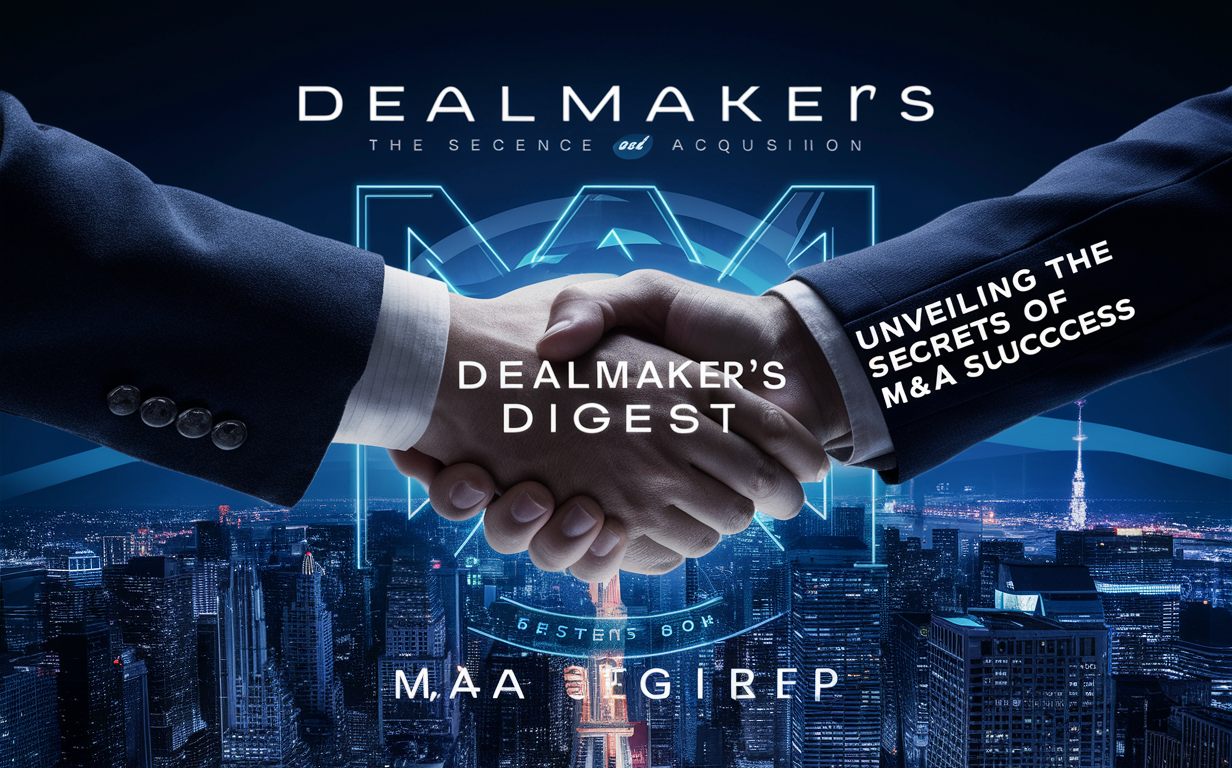Dealmaker’s Digest: Unveiling the Secrets of M&A Success
Understanding Mergers and Acquisitions
Mergers and acquisitions (M&A) are crucial business strategies companies use to achieve growth, gain competitive advantages, and enhance shareholder value. These strategic moves combine two companies into one entity or allow one company to acquire another, integrating its assets, resources, and market share. Companies often seek the expertise of M&A firms to navigate the complexities involved in these transactions. Utilizing such firms helps manage the intricate processes, legalities, and financial evaluations integral to successful mergers and acquisitions.
M&A activities are crucial for achieving long-term growth and sustainability in the business world. These endeavors enable companies to revamp their business models, gain new technological capabilities, and better serve their customer base. Moreover, M&A can streamline operations, enhance competitive positioning, and create additional value for stakeholders, making it a preferred strategy for companies looking to scale rapidly or enter new markets.
Critical Benefits of Mergers and Acquisitions
One of the primary advantages of M&A is the potential for cost synergies through economies of scale. By consolidating operations, companies can reduce redundancies, enhance productivity, and lower costs. The combined entity can leverage shared resources and spread fixed costs over a greater output, improving efficiency.
Other key benefits include:
- Diversification of Product Lines: M&A can broaden a company’s portfolio by adding new products and services. This diversity reduces the risks of market turbulence and reliance on a specific product range.
- Reduction in Competition: Merging with or acquiring competitors can help reduce market competition. This consolidation may result in increased market share, enhanced pricing power, and a stronger foothold in the industry.
- Market Expansion: Through strategic M&A activities, companies can enter new markets and geographic regions. This access to new customer bases and local expertise can drive revenue growth and international brand recognition.
- Enhanced Financial Performance: These activities often improve financial metrics, such as revenue and profitability, by optimizing operations and capitalizing on new growth opportunities.
Common Challenges in M&A
Despite the benefits, M&A activities are fraught with challenges. Some of the common obstacles include:
- Cultural Integration: Merging distinct corporate cultures can lead to clashes and conflicts. Aligning different organizational values, management styles, and work practices is critical for achieving a cohesive and harmonious working environment.
- Regulatory Obstacles: Manoeuvring the intricate regulatory maze can be challenging, especially in cross-border transactions. Compliance with legal, tax, and environmental rules requires thorough attention to detail and expertise in various jurisdictions.
- Technology Integration: Aligning and integrating multiple IT systems and processes can be technically demanding. Ensuring that technological infrastructure is compatible and scalable is crucial for maintaining operational continuity and data integrity.
- Due Diligence: Ensuring meticulous due diligence to uncover potential liabilities and risks is essential but often time-consuming. This process involves a comprehensive assessment of financial statements, legal agreements, and operational metrics to identify any hidden issues that could impact the success of the M&A.
Strategies for Successful M&A
Achieving a successful merger or acquisition requires a comprehensive strategy. Key strategies include:
Thorough Market Analysis
Detailed market research helps understand industry trends, competitive landscapes, and potential growth areas. This analysis provides insights into market dynamics, customer preferences, and emerging opportunities, enabling companies to make informed decisions and develop targeted strategies.
Transparent Communication
Frank and open dialogue with all parties, such as staff members, clients, and investors, ensures smooth transitions and maintains trust. Clear and consistent messaging can alleviate uncertainties, foster buy-in, and promote a collaborative atmosphere throughout the M&A process.
Alignment of Corporate Cultures
Ensuring that the corporate cultures of both entities are aligned can mitigate potential conflicts and enhance collaboration. This alignment involves understanding and respecting each organization’s values, practices, and employee expectations, fostering a shared vision and cohesive work environment.
Post-Merger Integration (PMI) Plan
A well-defined PMI plan is essential for streamlining operations, integrating staff, and ensuring that the combined entity functions cohesively. This plan should outline critical milestones, responsibilities, and timelines, emphasizing efficient integration of processes, systems, and personnel to achieve the desired synergies and business objectives.
Case Studies of Successful M&As
Examining successful M&A case studies provides valuable insights. Here are a few notable examples:
Exxon and Mobil Merger
The 1999 merger of Mobil and Exxon is a classic example of achieving significant synergies and long-term growth. The combined entity leveraged its enhanced technological capabilities and extensive market reach to become an industry leader. This merger resulted in operational efficiencies, expanded exploration opportunities, and strengthened financial performance, setting a benchmark for successful M&A strategies.
Disney’s Acquisition of Pixar
Disney’s 2006 acquisition of Pixar is another notable case. This strategic move allowed Disney to revitalize its animation division, creating blockbuster movies and enhancing financial performance. Integrating Pixar’s innovative storytelling and technological prowess with Disney’s marketing and distribution strength exemplifies the potential of M&A to drive creative and commercial success.
Facebook’s Acquisition of Instagram
Facebook’s 2012 acquisition of Instagram helped the social media giant diversify its platform offerings and capture a broader audience. This acquisition has been instrumental in maintaining Facebook’s dominant position in the social media landscape. By integrating Instagram’s user-friendly interface and visual content focus with Facebook’s expansive network, the acquisition delivered substantial value and growth potential.
Future Trends in Mergers and Acquisitions
The landscape of M&A is continually evolving. Key trends to watch include:
- Technological Advancements: The role of technology in M&A is becoming increasingly significant, with AI and machine learning aiding in data analysis and due diligence. These technologies can streamline processes, enhance decision-making, and uncover insights that drive more informed and efficient transactions.
- Emphasis on Sustainability: Companies increasingly focus on sustainable practices in their M&A activities, aligning with environmental, social, and governance (ESG) criteria. This pattern indicates an increasing understanding of the significance of sustainability in creating long-term value and resilience in business operations.
- Cross-Border Transactions: There is a growing trend in cross-border M&As as companies seek to expand their global footprint and access new markets. Globalization, technological advancements, and pursuing growth opportunities beyond domestic borders drive this trend. Successfully navigating cross-border transactions requires understanding diverse regulatory environments, cultural differences, and market dynamics.
Staying abreast of these trends can help companies navigate the future M&A landscape effectively and seize emerging opportunities. By leveraging technological advancements, embracing sustainability, and pursuing strategic cross-border transactions, businesses can position themselves for achievement in a world that is becoming more linked and dynamic.
Stay in touch to get more updates & news on Franciscotribune!





